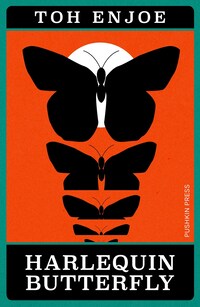Harlequin Butterfly by Toh EnJoe
 Wednesday, March 6, 2024 at 9:59AM
Wednesday, March 6, 2024 at 9:59AM 
First published in Japan in 2012; published in translation by Pushkin Press on March 5, 2024
Harlequin Butterfly seems more like a series of thought experiments than a novel. It might best be viewed as a meditation on language. Make of it what you will. Most of the Japanese fiction I’ve read has been accessible to my western sensibility, but Harlequin Butterfly is a bit of a puzzle. I don’t know if that’s because of a difference in culture or if my mind is simply too dull to appreciate Toh EnJoe’s story.
A. A. Abrams is a frequent flyer. In fact, flying is about all he does. When the plane is in the air, Abrams removes a small net made of silver thread that he uses to capture fresh ideas. In no other location are ideas as plentiful as those that come loose in the cabin of a jumbo jet. The net is later said to catch luck or opportunity, but in the beginning the net captures ideas that only exist mid-journey, ideas that are left behind as the body moves forward.
A passenger sitting next to Abrams (in coach, where all the best ideas are found) apparently narrates the first chapter. The narrator can’t read on a plane (or any other form of transportation), perhaps because her thoughts can’t keep up with the speed of the vehicle. Thoughts flitting out of heads moving at a high speed may explain why ideas are most easily captured on an airplane. Speaking to the passenger, Abrams conceives the idea of a book that can only be understood when the reader is flying. Abrams writes To Be Read Only on an Airplane, a book that oddly gains traction among readers who are traveling by sea on luxury liners.
Abrams reappears later in the novel, sometimes in a different gender, once at an earlier time. At some points Abrams is alive and at others is remembered in death. And then we learn that someone else (probably) wrote To Be Read Only on an Airplane — unless the alternate author is actually Abrams in a different guise.
In the second chapter, the focus shifts to Tomoyuki Tomoyuki, an author who has written books that are meant to be read only under specific circumstances, including (you guessed it) while traveling. Most have gone unpublished. They are written in multiple languages including a simplified version of Latin — invented by a mathematician — that nobody speaks. To Be Read Only Under a Cat achieved some success after reading it became the trendy thing to so.
In this chapter, it seems that Abrams is a fictional character who appears in To Be Read Only Under a Cat. Yet there seems to be an Abrams Institute that is tracking down and collecting (and maybe stealing) Tomoyuki’s work. Whether Abrams is real or imagined, whether Abrams or Tomoyuki writes the books (or each writes them independently), doesn’t seem to matter as Tomoyuki understands reality to be relative and fluid.
One of Tomoyuki’s works seems to be a meditation on writing. He explains that he writes because he likes the sound of certain words linked together, a sound “that makes me write things I wasn’t even thinking.” Harlequin Butterfly often comes across as a stream of strangely connected thoughts. Perhaps Toh Enjoe didn’t realize he was having those thoughts as he composed the novel.
Another chapter analogizes kitchens to dictionaries. Both are full of ingredients. When you don’t have the right ingredient, you can make do with another. Ingredients can be combined in various ways and some combinations are preferable to others. The sound of an ingredient (coriander) sparks memories of many things all at once: smells and colors and people and the “bustle of life.”
Language is also analogized to needlework, stitches creating something new, expanding like a conversation, “twisting and turning until the day is over.” Stitching with an old woman helps the narrator learn the woman’s language. Like needlepoint or any craft, writing is an act of creation that might be finished or unfinished, its form “constantly changing, cycling through the stages of transformation, setting new life in motion.” The narrator wonders whether a story written in one language might be incoherent but make perfect sense when translated into another.
These are interesting ideas. I’m not sure they add up to a coherent story but the ideas themselves call the notion of coherence into question. Each chapter of Harlequin Butterfly seems to have a different narrator, although it also seems that they are different forms of the same narrator. At some points, it seems that the story’s narrator is searching for Tomoyuki. At some points (sometimes the same points), it seems the narrator might be Tomoyuki. The final chapter suggests that the narrator is someone (more precisely, something) entirely unexpected.
I’m recommending Harlequin Butterly for its strangeness. Readers who expect stories to have straightforward narratives that are easily understood will want to steer clear of the novel. Readers who appreciate the power of language might be entertained by the EnJoe’s invitation to perceive that power in new ways. Readers with time on their hands might want to read it twice, as I suspect a second reading would contribute to the reader’s understanding or appreciation of the novel’s narrative structure.
RECOMMENDED
Reader Comments